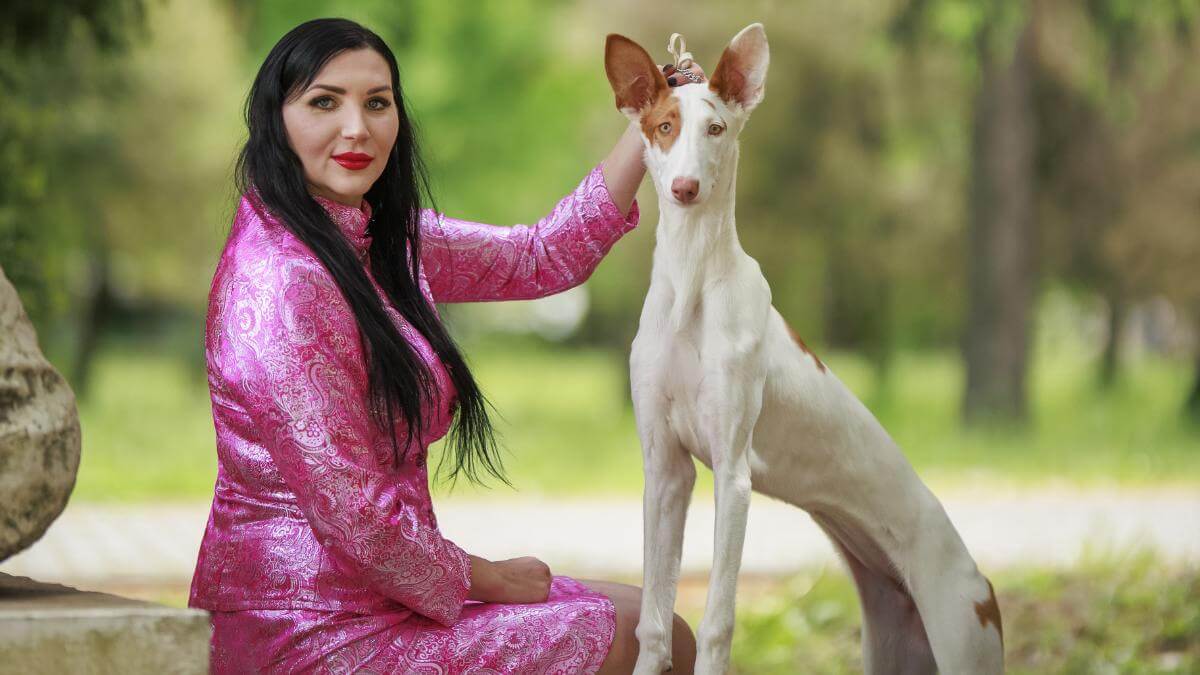
Home » Michaela Kamenárová | La Princesa Rosa de Podi

Michaela Kamenárová
1. My name is Michaela Kamenárová, and I am from Slovakia, living near Bratislava, the capital city. I am 35 years old and have been involved with dogs since I was about 10, when I started working with shelter dogs. I gradually became interested in dog shows and breeding, graduating from a veterinary high school; my love for animals has been a lifelong activity. I have been running my kennel, La Princesa Rosa de Podi, for more than eight years.
2. The Podenco Ibicenco is known for its overall look, noble movement, distinctive ears, and triangular-shaped head. The entire appearance of the Podenco is an excellent tool for determining its successful hunting ability. It is desirable to maintain these traits in breeding and not to follow modern trends in cynology that could endanger the breed’s speed or hunting ability.
3. As with every breed, I believe we have seen an enormous increase in the production of puppies, and quality does not always go hand-in-hand with quantity. Breeding for quantity is very undesirable for a breed like the Podenco Ibicenco, and I dare say it can lead to poorly bred dogs, and eventually, to the deformation of the breed’s structure and type.
It is great that the modern era allows breeders to connect worldwide, but on the other hand, it is not valuable to use a dog for breeding just because it is papered. A breeder should carefully select breeding dogs, considering health, physical characteristics, character, and contribution to the breed. Thus, just because a breeder produces 50 or more puppies a year does not mean they are a quality breeder. Choosing a breeder should depend on their goals, not their numbers.
4. The new online era offers easier communication between breeders, various health tests, and new trends in DNA testing, which are very important for all breeds. I have completed DNA profiles and eye exams, and I am considering expanding testing of my dogs for other diseases as well.
The newer technology is also significantly better for the storage of frozen semen, which I have used in my kennel. I would certainly welcome better health tests specifically for this breed; this will naturally take time, and I believe that, thanks to more responsible breeders, it will improve in the future.
5. Awareness about the breeding of non-pedigree dogs is never as large as the production of these puppies. Of course, there are exceptions, even among breeders of pedigree dogs who produce a very high number of puppies, even in my breed, and this negatively impacts the population, already burdened by many homeless dogs.
Social media gives negative publicity a bigger reach, but in many cases, people still behave irresponsibly when buying a dog, wanting to quickly and instantly own a puppy, which leads to the undesired overproduction of puppies. I think we should not relax but, on the contrary, increase efforts to publish the negative impact of overproduction. Young people today have all the information at their fingertips, so it should be easier to choose their breeder more responsibly.
6. I do not compete in dog sports, so I will instead speak about trends in dog shows. I am a handler and show not only my dogs but also dogs from all FCI (Fédération Cynologique Internationale) Groups. I see how the promotion of exaggerated physical traits at shows can negatively impact a breed. When judges, handlers, and breeders prefer a different type or trait in a dog just to win—even if that trait is undesirable—it is problematic. It is up to breeders whether they want to go along with this or stay true to the original breed type. There are understandable concerns, as we already see examples where working and show lines of some breeds vary so greatly that, they almost seem like two separate breeds. Trends should never override the breed’s functionality and its Standard.
7. One positive thing is that, for less common breeds like the Podenco Ibicenco, competition at shows is growing, allowing breeders to compare the quality of their breeding programs. This is especially relevant at major shows like EDS (European Dog Show), WDS (World Dog Show), or Crufts. I believe that if someone wants to take on the challenge of being a good breeder, they should have a general overview of the competition, which includes competing against them at shows. However, I emphasize that the winner is not always the best representative of the breed. Thus, building an overview should not be based only on winners but on the dogs’ typical physical traits, character, and, above all, health.